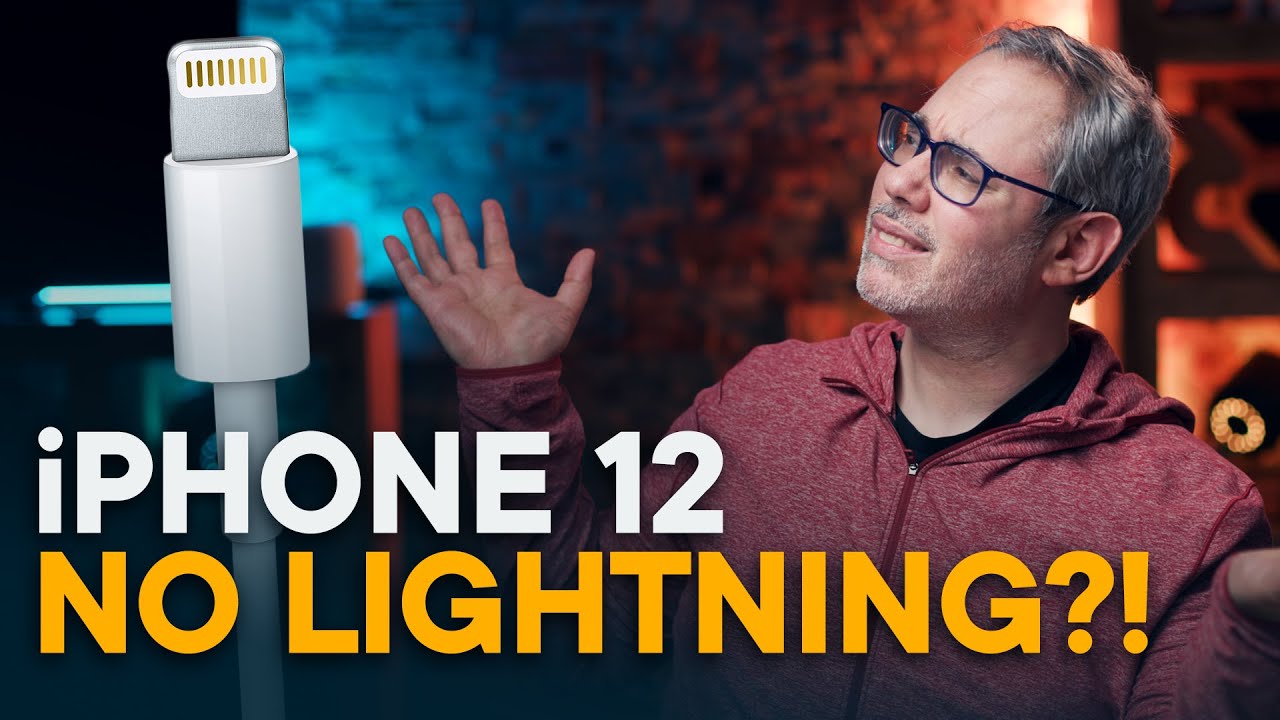– Sponsored by Ting. There was still rumors going around because there are alwaysrumors going around, that Apple is gonna kill the lightning port on the iPhone , not to supersede it with USB-C , no, merely kill it, to watch it die. Now, it probably won’t be withany of the iPhone 12 models , not the ones released this year. I’ve been doing a ton ofcoverage on all of those though, so, make sure you reached thesubscribe buzzer and button, so you don’t miss any of it. But, could be as soon as the next iPhone, soon as next year. And it’s not just Apple, the part manufacture seemsto be moving that path, which has caused a lotof parties to complain, some people to champion it, but me, I time wanna explain it.Almost four years ago Apple removed the 3.5 millimeter headphone jack from the iPhone 7. They weren’t the first, HTC had a bunch of phoneswithout a headphone jack times before the iPhone, including their very first Android phone. But when Apple does something like that, because Apple drives so muchproduct and so many headlines, people given attention. Direction start, other fellowships follow. Apple’s slope back then, was that the 3.5 millimeterheadphone jack was old, outdated, a unitasker, somethingAlton Brown would hate. And anything it is possible to do, relieving could just do better, except, you know, work withcross-device headphones that allow for a simultaneous charge and audio without a dongle. It also made water resistance better, because while almost allof the ports in the iPhone have been shut, you’re still supposed to dry them off before plugging anythingelectric claim into them and a lot of people simply don’t.So you still get corrosionand occasional suddenlies. Same with the home button that Apple superseded the very same year. They removed the mechanical substitution and superseded it with proprioceptive lie, a taptic response that exclusively obligates it feel like it’s clicking, when certainly it’s just solid stuff. And they did it becausethose mechanical permutations wore out in a manner that was the virtual feedback presumably precisely won’t ever do. Same with other corporations changing things like the two sides buttons withsqueezes and the like. Now, if Apple had usedthat minute in history, the moment when theydeleted the headphone jack to likewise switch the iPhonefrom lightening to USB-C to something that almost every device would soon make a standard and would allow almost anyheadset to plug in with, albeit still at the expense of billing, perhaps the world would be avery different place right now.But, for a variety of reasons I was mentioned in a video some weeks ago, and yeah, dangerously hitthat agree button, that only didn’t happen. AirPods happened instead and the very next year, inductive blame. So , now we’re leave behind the lightning port and maybe that’ll soon go away. And for the very same reasons, to simplify productionand water resistance, to reduce complexityand mechanical lack, to stop people from plugging cables that fray into portsthat get wet and soiled. And of course, to prevent bad actors from plugging in cables to try and pull out our private data. To take one more step towards the kind of wireless worldor if you’re still not prepared to take more one more infuriating push. So, if and when Apple doesdelete the lightning port, we’ll all clearly have tojust start accuse inductively, which some people announce wirelessly.But since I still have to plugthe damn thing into the wall, I’m just gonna keepcalling it inductively. The Palm Pre famously launched with inductive chargingmore than a decade ago. Numerous Android telephones havehad it for almost as long. Apple introduced their version back with the iPhone 8 and the iPhone 10 and blessedly they stuckto the CHE standard. Now, even though CHEchargers are a standard, they’re by no means ubiquitous , not the acces USB-A charging bricks are, or even USB-C charging bricksare starting to become. They’re too bigger becauseinstead of merely a small USB-C or a lighten push on the end, they have a big old-time honken hockey puck that you still need to stickyour phone on top of to bill. And if you’re trying to useyour telephone while accusing it, CHE chargers clear that justway more difficult as well. And they’re still nowhere nearly as efficient as plug-in chargers even the faster and more proprietary ones that some people are carrying. In other names, they don’ttransfer ability as well, so you get all the heatwithout all of service charges and that’s just not good forlong-term artillery health.But most super fast chargers aren’t immense for battery state either and a lot of people still getsuper agitated about those, because for a lot of beings, accessibility now pulsates longevity later. So, I don’t know. All this to say, thatwhile inductive charging is still far from perfect, at least this part of goingportless is a solved problem. Once upon a time in aniTunes far, far away, you used to have to plug your iPhone into a computer to transferanything and everything, nevermind your music, even your contacts, gravely ask your grandparents. But then, starting with iOS 5, Apple made the iPhone to iCloud and most of our data merely started to sync. Same with assistances fromGoogle and Microsoft and countless, many others, eventually up to and including things likepasswords, photographs and videos, substantiates, pretty much everything. With iOS 8, we got continuity, so we could AirDrop files, handoff positional territory and apps, tether without a leash. And streaming began to overtake downloading and transferringover a cable as well, from Spotify, Apple Musicand Netflix and Apple TV and Kindle and Apple Books. Wired ties-in arestill much, still faster, but Apple never evenbothered to include faster and more modern wiredconnections on iPhones.Wireless, on the other hand, entirely different story. Apple’s always been among the firstly to add better and fasterwireless standards including Wi-Fi 6 on the latest iPhones. And that makes even a coupleof minutes of 4K video isn’t torturous to transferwirelessly anymore, but anything longerand likely anything 8K, when that becomes a thing, probably still will be. So again, it’s not a perfectreplacement for cabled, it transactions substantial utility and hurried for a significant convenience, but moving portless it’s also a answered question. Where it all starts to get tricky though, is where things like structure rebuilds, both basic and DFU mode.You know, when a method orsoftware update or something else just goes totally wonky andhave to plug into iTunes or the Finder now and just factory reset and reload your entire iPhone. I intend, how would you even plug in without a push to in? The Apple Watch and the AppleTV both have secreted ports but they’re only meant to be accessible by AppleCare techniciansand as exasperating as it is to have to sendin or take in your TV or your watch for servicing, I can’t even imagine howfrustrating it would be to have to do that with your phone.And this is yeah, as of right now, a entirely unsolved difficulty, at least on the iPhone. Apple is introducing something fairly new and something really cool in Apple Silicon Macs forlater this year though. Basically they’ll have a negligible, separate macOS environmentin a obscure receptacle that lets you re-install macOS, even the macOS recovery, if and when you need to. Could that work for an iPhone with iOS in a species of iOS recovery utility and internet recover onboard? Maybe.We’ll utterly have to wait and encounter, but meanwhile lemme know yourthoughts in specific comments. Other issues is existing supplementaries. When Apple switched fromthe 30 -pin dock connector to the lightning port in2 012, parties were mad. We had all kinds of cablesand docs and sound systems and in-car systems withdoc connectors on them. And we really did notappreciate the one-way ticket to dongle town Apple was throwing us. Sorry, I mean, adaptor invoice. And that was after a decade of 30-pins. And that’s been one of its most important proofs against exiting USB-C now as well. All the mainstream iPhone owners “il just go” about their daily lives and if you swap theirports, they will cut you. So just imagine what they’ll do if you don’t exactly swap those ports, but try to delete them entirely. Yeah, delete you entirely.People who utilize HDMI and other AV adapters or camera kits, or pluginto mics, or divinity, CarPlay. Apple can count on time and brand-new pieces stirring some of that only obsolete. But CarPlay, even withthe wireless version starting to trickle outthe OG cabled form isn’t going anywherefor probably a decade. The automotive industryis collegial by comparison to the phone industry.So what’s the answer there? An Apple wireless to lighteningdongle, sorry, adapter, like the AirPods to 3.5 millimeter headphone jack dongles, some of us have been using on planes? If you like me, think therebetter be a good answer to all of this, before we understand any of that, precisely remove a like below. On the flip side, in additionto removing a potential quality of mechanical omission, removing the lightning port too removes a possible onrush point. I necessitate, we’ve all seenphysical access be translated into digital access justnumerous goes over the years.Compromised accessorieslike juice jacking, evil mansion workers pluggingin and taking your nonsense. And people were trying to justtrick you into plugging into malicious blame terminals, is why Apple added that whole, do you trust and passcodepop-up to iOS a few years ago. Likewise, perfectly, likewise. The business that collectand sell iOS manipulates on the pitch-black or gray marketand lease or sell caskets, they try to break intodevices over hard cables, simply all of them more. Removing that access won’t suddenly clear the iPhone intrusionproof or anything, but it will mitigate againstsome of types of interferences. And, if and when Apple gets an illegitimate searchand seizure solicits, something additional lawful, demanding they cure break into a maneuver, they can answer in their most, very favorite way possible. It’s not that we won’t do it, it’s that we simply can’t do it. What none of this will help you with, is saving your coin, butthat’s where Ting comes in. And they can help you save money no matter which iPhone orany phone you’re using, specially if you’reworking from home right now with precisely tons of Wi-Fi available and no need to pay for any more data than you’re actually using.Same with talk, same with text. Ting offers coverage onVerizon, T-Mobile and Sprint. No matter where you are or where you go, you’ll have more serviceoptions in more lieu. And it works with almost any phone, the iPhone, utterly, the Google Pixel, sure, Samsung Galaxy, sure, pretty much anything. And it’s super easy to get started. Just go to rene.ting.com, create an account. They send you a SIM card, you positioned it in your phoneand you are good to go. And if you have any issues they have award-winning customer support, that’s not just ready, but happy to help you out. The median Ting bill is just $ 23 a month with no contracts , no commitments.And since you’re watching this video you can get a $ 25 service creditto try Ting out right now. Bring your own phone, bringyour own number if you want to. Just go to rene.ting.com or clink the link in the specific characteristics, be seen to what extent much you can save and get $25 off. Thanks Ting. Thanks to all of you for your endorsement, check out my iPhone 12 playlist right there and see you next video ..





